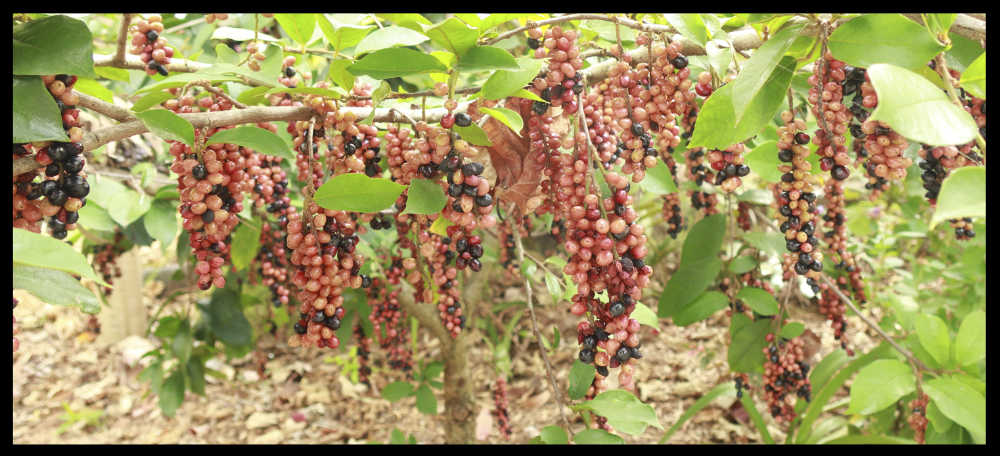Antidesma.
Family Phyllanthaceae > Subfamily Antidesmatoideae > Tribe Antidesmateae > Subtribe Antidesmatinae.
There are 101 variable species with some from Africa but most from S. E. Asia to Australia.
They are shrubs or trees up to 30 m high.
Young stems may have lenticels (small nodules) and no hairs or a few to dense simple white or brown ones.
The simple alternate leaves are on a petiole up to around 1.5 cm long that may be swollen at one or both ends and smooth or hairy.
The sometimes leaf-like stipules, from 1 mm to 3.5 cm long and 0.2 to 4 mm wide may be permanent or deciduous.
They may be smooth or have white or brown hairs.
The mostly evergreen leaves can be from 3 to 55 cm long and 0.5 to 25 cm wide.
They are ovate, obovate or elliptic to oblong with a round to pointed tip often with a mucro (small abrupt point).
The base can be rounded, heart or wedge-shaped and it may run down the petiole.
There may be no hairs or the lower surface many have white or brown ones all over or just on the midrib and main veins.
There may be domatia (small pits with hairs) in the axils along the midvein.
Antidesma have unisexual flowers with males and female on separate plants.
Inflorescences are mainly axillary with some on the stems or terminal.
They are mostly racemes or raceme-like as flowers have a very short or no pedicel.
(Racemes are single flowers, on a stalk or pedicel along a midrib with the lower flowers opening first.)
Inflorescences, from 2 to 24 cm long may be simple to much-branched with up to 20 racemes.
The yellowish-green flowers are densely to widely spaced.
Other inflorescences are 2 flowers, on pedicels in each axil.
The central axis or midrib may be smooth or have brown or white hairs.
At the base of each flower is a bract up to 1.5 mm long with or without hairs.
Flowers, up to 3 mm long and wide have 5 to 8 sepals and no petals.
Sepals are free or fused from half to two-thirds of their length.
There may be white or brown hairs on the outer surface and the base of the inner.
Male flowers.
There are 2 to 8 stamens with free filaments 0.5 to 2.5 mm long.
The 0.6 mm anthers, extending past the sepals, open outwards through longitudinal slits.
The connective tissue between the anther sacs is elongated.
The nectary disk, external to or around the filament bases can be a ring or free lobes and smooth or hairy.
There may be a rudimentary smooth or hairy ovary (pistillode) or none at all.
Female flowers.
The superior ovary has one locule with 2 ovules and a style with 2 to 6 stigma lobes.
The nectary disk at the base of the ovary may be smooth or hairy.
There are no stamens or rudimentary infertile staminodes.
As the fruits develop the midrib holding them elongates up to 2 or 3 times its original length.
This infructescence is usually pendulous and can be up to 65 cm long.
When flowers are on a pedicel this can also elongate up to 23 mm.
(Some species just have paired fruit in each axil).
The drupe-like fruit, up to around 1 cm long can be spherical, obovate, obliquely ovate or ellipsoidal and are sometimes laterally compressed.
The style may be on the end or slightly lateral.
The smooth or softly hairy fruit ripen from green through white and red to black and each has 1 seed or rarely 2.
J.F.


